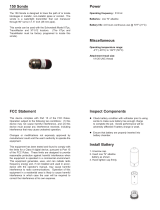Using the Signal Generator: Direct Connection
4. Place the Earth Stake in the ground (having first searched the area
for buried cables with the locator).
The ideal position for the Earth Stake is at right angles to the
assumed line of the pipe and the full length of the direct connection
leads away from the pipe access point.
5. Connect the black earth lead to the Earth Stake (or the alternative
earth point). If your earth point is too far away from the pipe access
point for the black earth lead to reach then use the yellow 10 metre
auxiliary earth lead instead.
6. As the earth lead is connected to the earth stake the audible
signal from the Signal Generator should change in tone. The
greater the change in tone, then the better the signal will be on
the metal pipe.
If there is no change of tone at all it may be that some dirt, rust
or paint on the pipe is preventing the direct connection lead from
making a good contact with the pipe. Alternatively it may be that your
earth point is at fault. Change the position of the earth stake
or use an alternative earth point.
NOTE If it is not possible to use the Earth Stake use a nearby metal fence post, manhole cover or gully cover. DO
NOT use something that may have another metallic service attached to it, such as a metal street lighting column.
NOTE If the Signal Generator tone does not change then there is no signal being transferred onto the service.
SG-V only
The SG-V Signal Generator will also give a visual representation of the quality of the connection in addition to the audible
tone change. The greater the response on the display then the better the signal will be on the pipe.
15


























